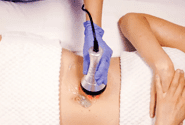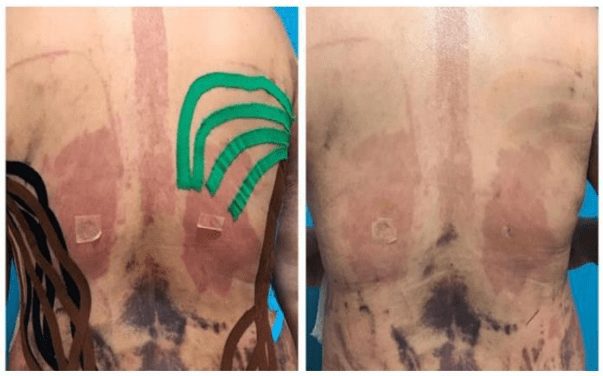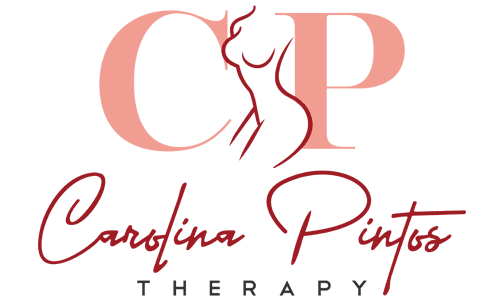Scar Tissue & Fibrosis Treatment
Our scar tissue treatment is uniquely crafted to reduce scar tissue and enhance healing. Our team is thoroughly trained in the nuances of inflammatory stages, focusing initially on managing inflammation during the acute phase. We begin our specialized treatment only after this critical period, prioritizing safety and maximizing effectiveness. This careful approach ensures a faster, more comfortable recovery. It’s no wonder that over 25 doctors in Houston exclusively trust our clinic with their patients’ care.
Signs of scar tissue and/or Fibrosis
Hardness under the Skin: The surgial area may feel unusually hard or firm.
Lumps or Nodules: You may notice lumpy textures or small nodules forming beneath the skin surface.
Skin Tightness: The skin may feel overly tight or restricted in the affected area.
Discoloration: There could be changes in skin color, such as reddening or darkening, on the surgery area.
Uneven Skin Surface: The skin may appear uneven or irregular, differing from its usual texture and appearance.
Pain or Discomfort: Fibrosis can cause a feeling of discomfort or pain in the affected area, especially when touched or during movement.
Reduced Mobility: In some cases, fibrosis may limit the range of motion or flexibility around the surgery site.
Our Scar Tissue Services

Our clinic is conveniently located on the west side of Houston in the Energy Corridor, accessible to those in Katy, Spring, Sugar Land, Bellaire, and other surrounding areas
Scar Tissue & Fibrosis Treatment
For optimal results we recommend booking multiple sessions
High-speed vibration technology, featuring high-frequency, short-stroke vibration energy, expertly targets therapeutic areas to reduce pain and release scar tissue. The motorized hammer device in this technology offers dual motion capability, rotating at over 10,000 revolutions per minute for deep, effective therapeutic penetration. Combined with other advanced clinical techniques, the Pro3 system delivers exceptional outcomes, particularly in alleviating pain and breaking down scar tissue.
Cupping therapy is an effective approach to enhance post-surgery flexibility and promote pain relief. The therapy’s suction technique not only increases collagen and elastin but also releases fascia and breaks down scar tissue, leading to a significant improvement in range of motion. Additionally, it stimulates blood flow to the targeted areas, further facilitating mobility. Supported by research, cupping is recognized as a safe and effective method for increasing mobility and aiding the healing process.
 Vacuum treatment is another effective post-operative recovery method, utilizing a mechanical rotating wheel with a vacuum to massage the skin to release the fascia and reduce scar tissue.
Vacuum treatment is another effective post-operative recovery method, utilizing a mechanical rotating wheel with a vacuum to massage the skin to release the fascia and reduce scar tissue.
![]()
 Radio Frequency (RF) stimulates the production of collagen and elastin, making scar tissue more flexible, which facilitates its release and the use of suction cups or a suction machine.
Radio Frequency (RF) stimulates the production of collagen and elastin, making scar tissue more flexible, which facilitates its release and the use of suction cups or a suction machine.
![]()
 In some cases where scar tissue has formed in fatty areas, the use of ultra cavitation is necessary to minimize the fatty layer so that the tissue can be released. Similarly, ultracavitation is used to reduce seromas with the supervision and permission of a doctor.
In some cases where scar tissue has formed in fatty areas, the use of ultra cavitation is necessary to minimize the fatty layer so that the tissue can be released. Similarly, ultracavitation is used to reduce seromas with the supervision and permission of a doctor.
![]()
$19 | Add-On Service
 Kinesiology tape, also known as kinesio tape or simply KT tape, is a popular form of athletic tape that has gained recognition for its therapeutic properties. This elastic adhesive tape has been utilized for a wide range of conditions, including post-plastic surgery.
Kinesiology tape, also known as kinesio tape or simply KT tape, is a popular form of athletic tape that has gained recognition for its therapeutic properties. This elastic adhesive tape has been utilized for a wide range of conditions, including post-plastic surgery.
Have more questions about KT Tape?
Click HERE to Read More.
Fibrosis Treatment Session
50 Minutes
713-474-4774
*Get $15 OFF on your 4th visit
with our loyalty program!

Give a Gift of Healing
An eGift card for a lymphatic massage is a thoughtful and effortless way to show you care.
Rewards Program
Earn Points
Join our rewards program and earn a point every time you book an appointment at our clinic.
Earn Discounts
Get $15 OFF after your 4th visit!
Redeem Points
Use your discount immediately, or convert your rewards into gift cards for friends or family.
Why Choose Carolina Pintos
for your Post-Op recovery?
Personalized Care That Meet Your Unique Needs
Our expertise in post-surgery care, grounded in a deep understanding of the different inflammatory stages, ensures a safer and more effective recovery. By evaluating each patient’s specific situation before treatment, we can create a customized approach, leading to a better healing experience.
Safe And Proven Techniques
Our approach to lymphatic drainage is carefully performed to effectively reduce swelling. In cases where a patient has a JP drain, we seamlessly integrate this into our drainage process. We prioritize safe practices, avoiding reopening incisions post-drain to prevent complications. Our treatments are carefully timed, treating scar tissue only after the acute inflammatory stage has surpassed, ensuring a coordinated and safe recovery. We also work closely with your surgeon for streamlined and effective healing.
Complementary Surgery Garment Assistance
We recognize the importance of surgical garments in enhancing post-operative recovery. Our service includes assisting clients with fitting these essential garments, tailored to individual needs regarding size, compression level, and specific areas of recovery. We ensure that as your body heals and changes, your garment continues to fit perfectly, thus maximizing comfort and effectiveness throughout your recovery.
Educational Support and Home Care Guidance
We focus on thorough educational support and home care guidance for our patients. Our team gives detailed advice on activities to do and avoid at home, customizing suggestions based on each patient’s specific surgery and recovery needs. This includes key dos and don’ts to avoid complications, lower infection risk, and ensure overall health.
Praises From Our Clients
Frequently Asked Questions (FAQ)
Q: How long does it take for scar tissue to heal after surgery, making it harder to undo?
A: The time it takes for scar tissue to heal after surgery and become harder to undo varies from patient to patient. Typically, the initial healing phase, where the skin and tissue start to close and heal, takes about 1 to 2 weeks. Scar tissue begins to form and can last from a few weeks to several months, with well-formed scar tissue usually present by 6 to 8 weeks. However, the scar continues to mature and strengthen for up to a year or more. During this maturation phase, the scar may initially appear red and raised but will gradually flatten and fade. For optimal recovery and preventing excessive scar tissue formation, it is crucial to follow the therapist’s recommendations and engage in consistent treatment and therapy, often one session per week for 6 to 8 weeks, with some patients needing less time and others a bit more.
Q: Who would benefit most from our scar tissue and fibrosis treatment?
A: Our scar tissue and fibrosis treatment are ideal for those:
- Patients recovering from various surgeries: Especially those in the weeks or months post-operation who continue to experience stiffness and pain, where fibrosis might be impeding recovery.
- Individuals who have undergone cryotherapy: Those who have developed scar tissue as a side effect of treatments such as cryolipolysis, which can sometimes lead to fibrotic changes in the treated areas.
- People with chronic post-surgical pain: Including patients who have had surgeries like C-sections, hernia repairs, or orthopedic surgeries, and are suffering from lingering discomfort due to scar tissue.
- Individuals with cosmetic concerns about scars: Including those resulting from burns or other skin traumas who are seeking to improve skin texture and flexiblity.
- Clients who have undergone intensive body contouring procedures: Who require management of fibrotic tissue to ensure smooth results and optimal outcomes from their treatments.
- Athletes recovering from muscle injuries: Who need to break down fibrotic tissue to restore full range of motion and prevent long-term mobility issues.
- Patients with internal scarring from invasive procedures: Such as those with adhesions after abdominal surgeries, which can cause chronic pain and other complications.
- Aging individuals experiencing increased skin rigidity: Who want to maintain skin elasticity and reduce discomfort associated with aging-related fibrotic changes.
- People dealing with specific fibrotic conditions: Like Dupuytren’s contracture or Peyronie’s disease, where fibrosis significantly impacts functionality and quality of life.
Q: Is fibrosis the same as scar tissue?
A: While related, fibrosis and scar tissue are not exactly the same. Scar tissue is a type of fibrous tissue that forms as part of the body’s natural healing process following an injury or surgery, primarily composed of collagen. It’s a specific response to heal skin or tissue damage. On the other hand, fibrosis refers to the broader process of fibrous tissue formation. In essence, all scar tissue is a form of fibrosis, but not all fibrosis is scar tissue.
Q: How do you flatten scar tissue after surgery?
A: To flatten scar tissue post-surgery, we employ:
- Radio Frequency (RF) Therapy: Enhances the flexibility of scar tissue by stimulating collagen and elastin production, aiding in its release.
- Cupping Therapy: Improves flexibility and provides pain relief through suction. This method increases collagen and elastin, releases fascia, and helps release scar tissue.
- High-Speed Vibration Technology: Targets pain and assists in the release of scar tissue using high-frequency vibration, achieving deep therapeutic penetration.
- Ultra Cavitation: Aids in reducing fatty layers in scar tissue and seromas, facilitating tissue release.
These methods are used individually or in combination to effectively flatten and release scar tissue, enhancing recovery after surgery.
Q: Does scar tissue from surgery go away?
A: While scar tissue resulting from surgery doesn’t vanish entirely, its visibility and texture can be greatly diminished. The utilization of a blend of treatments aids in the formation of healthier collagen and its proper alignment, which contributes to an improved appearance and feel of the scar.
Q: When is it too late to treat scar tissue?
A: It’s generally never too late to start therapy for scar tissue. However, the earlier the intervention, especially during the scar’s maturation phase, the more effective it tends to be.
Q: Does scar tissue hurt when pressed?
A: Yes, scar tissue may hurt when pressed, especially if it’s still in the inflammatory or early remodeling phase. Sensitivity can be reduced with consistent treatment using the combination of therapies.
Q: What does scar tissue feel like?
A: Scar tissue usually has a distinctive feel compared to the surrounding skin. It tends to be firmer or denser, with a reduced elasticity, making it feel more rigid. The sensitivity of scar tissue can vary; some people might find it more sensitive to touch, while others might experience a decrease in sensation. The surface of scar tissue can be raised, as seen in hypertrophic or keloid scars, or it can be indented, like atrophic scars. Additionally, scar tissue often lacks the typical characteristics of normal skin, such as hair follicles and sweat glands, resulting in a smoother texture. The specific texture and feel of scar tissue largely depend on factors like the nature of the injury that caused it, the individual’s healing process, and their skin type.
Q: How do you break up surgical scar tissue?
A: Surgical scar tissue management involves a multi-modality approach. Initially, RF therapy is applied to soften the scar tissue, enhancing its malleability. This step is crucial in preparing the tissue for subsequent treatments. Following this, specialized techniques are employed to target the deeper layers of the scar, facilitating further release and remodeling. The process is further enhanced by vacuum therapy and massage, both of which are instrumental in aiding the breakdown and remodeling of scar tissue. This combination approach ensures a comprehensive treatment, addressing the scar tissue at various depths and stages of healing.



